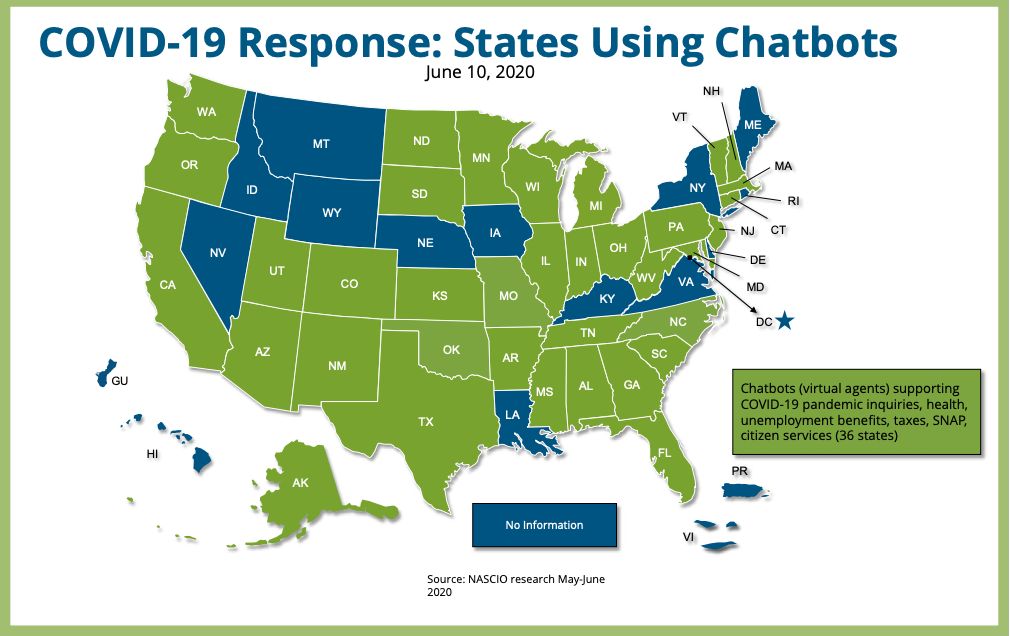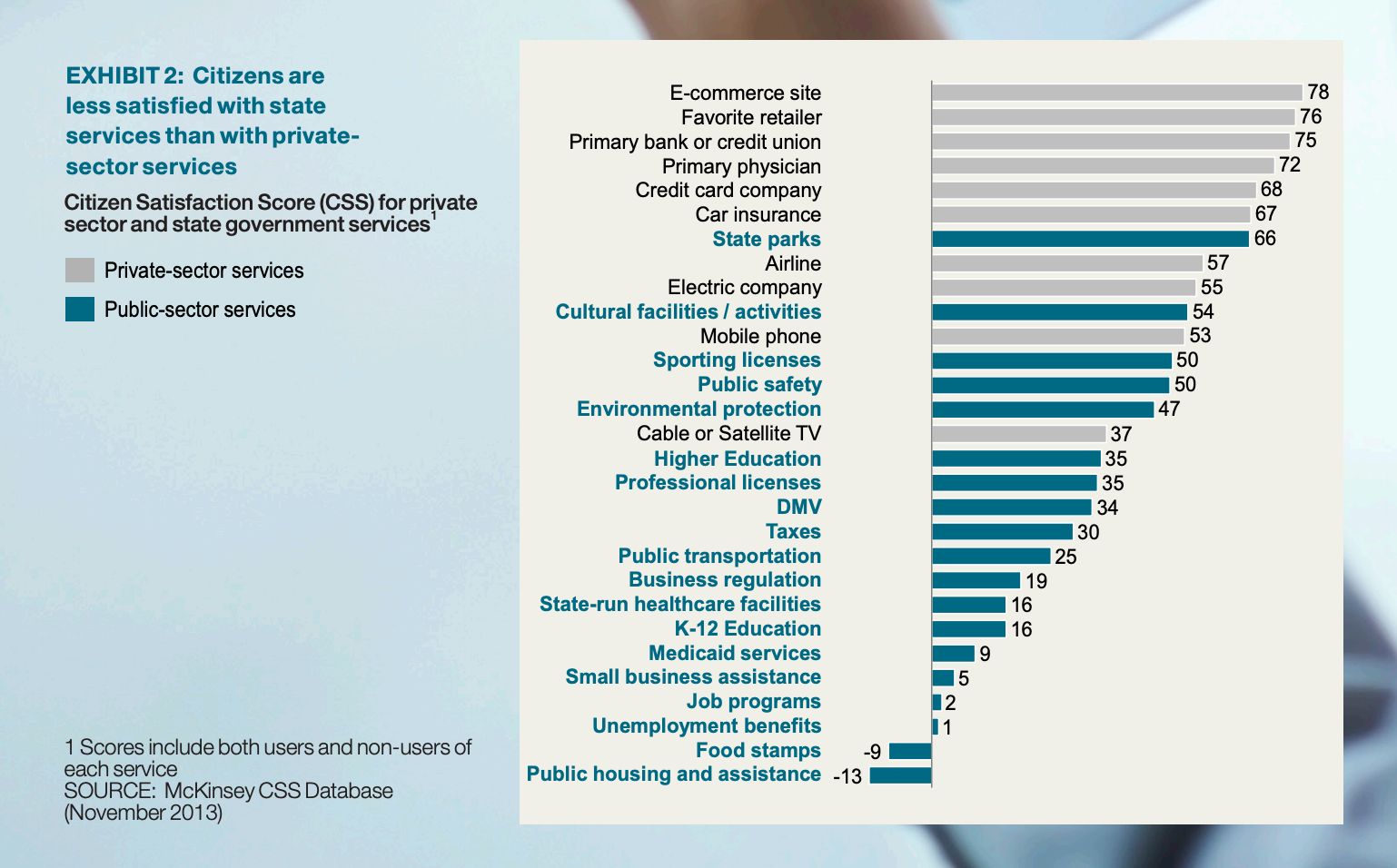Conversational AI for President: The Covid-19 Chatbot Use Case
Our interactions with government agencies hardly ever find their way into our dinner-table conversations, yet they play a huge role in our everyday lives.
From applying for benefits to renewing our driving licenses to paying our taxes, we turn to our governments — local, state, or federal — to accomplish our most important tasks.
Providing services to citizens is, in essence, the sole purpose of any government agency and the measurement by which these agencies are scrutinized, evaluated, and ultimately funded.
Now, more than ever, citizens expect easy access and seamless communication with their government agencies at all times. Gone are the days of long, straggling lines in brick and mortar offices; in 2020, citizens conduct almost all of their interactions with government agencies digitally.
A survey conducted by BCG found that 80% of respondents use their local government’s websites to access real-time public information such as weather or traffic, and 65% are using them to make payments for taxes and fines.
So, how are governments fairing in delivering the level of service their citizens demand, and what role is COVID-19 playing in getting them there?â€
Game Changer
â€In a 2017 Deloitte survey, 73% of state and local government officials believed their organization’s digital capabilities were behind those in the private sector.
But COVID-19 changed the paradigm, or more so, expedited processes that would have presumably taken decades to transpire otherwise. As state governments across the nation received millions of urgent queries from concerned citizens, eager to learn more about shelter-in-place restrictions, reopening policies, case counts, and more, a highly efficient, scalable, and easy to use solution was needed.
That solution turned out to be conversational AI.
At the time of writing, 75% of states have launched chatbots to help agencies answer unemployment and COVID-19 questions. 50% are now using a chatbot on their unemployment insurance websites.
Why did this happen?

Source: NASCIO

Texas Workforce Commission’s Virtual Assistant ‘Larry’ Source: Texas Workforce Commission
Conversational AI: A Catalyst for Customer-Centric Service
To explain how and why the spike in the adoption of conversational AI took place across the board, one needs to consider the use cases it fulfills for government agencies:
1.FAQs, Alerts & Information: Government agencies handle thousands, if not millions (depending on size) of citizen queries a day. Unfortunately, many agencies find themselves understaffed to handle the sheer volume of requests they receive, leading to an endless cycle of backlogs and disgruntled citizens. A 2018 OPM report states that “gaps in staffing levels were hampering performance or placing performance at risk as well as causing stress for overworked employees.â€Â A conversational AI virtual assistant can divert this pressure and act as the agency’s ‘digital front door,’ handling frequently asked questions, repetitive tasks, and more. It can even automate proactive outreach to citizens with relevant information and alerts, thus eliminating a considerable number of unnecessary queries and calls.
2.Taxation, Billing, and Employment: As of May, more than 40 million Americans have applied for unemployment benefits. One can only imagine the amount of paperwork and bureaucracy that accompany such an uptick in claims. As I previously mentioned, 50% of state agencies have already implemented a conversational AI solution to handle these applications, and for a good reason. A virtual assistant can replace obsolete forms with efficient, conversational flows and navigate tax-payers to the proper paperwork, guide unemployed citizens in applying for benefits, and easily collect billing information.
3.ID and License Renewal: It’s no secret that many people consider a visit to the DMV to be a less-than-ideal, time-consuming endeavor. A 2014 Mckinsey Center for Government report found that the average CSS (Citizen Satisfaction Score) across 15 states’ DMVs was only 34. This score can be significantly improved by funneling citizens away from long lines at DMV locations and moving a portion of the interaction online. A virtual assistant can fast-track the often sluggish pace of identification and license renewal for automobiles, state ID, businesses, and beyond, saving citizens time and effort while converting more renewal payments.

Source: McKinsey Center for Government, PUTTING CITIZENS FIRST: How to improve citizens’ experience and satisfaction with government services, 2014â€
4.Find Services, Programs, and Locations: No matter their size, all municipalities offer various services and programs. From job fairs to extracurricular activities and cultural events, citizen satisfaction scores are often directly correlated to the quality of programs and the ease in which citizens can enjoy these opportunities. A survey by Booz, Allen, Hamilton consultancy found that 56% of citizens would like their municipalities to make it easier to find information online. A virtual assistant ensures a steady flow of digital traffic to critical services and programs, quickly providing relevant information.
â€5.Schedule and Confirm Appointments: Although many tasks can now be accomplished online, from time to time, citizens are obligated to show up in person for various appointments, days in court, and committees. Conversational AI enables end-to-end online booking with governmental agencies using natural language, automating appointments, and logging relevant information to government databases.
â€Here to Stay
â€According to the National Association of State Chief Information Officers (NASCIO), all 75% of states who have implemented conversational AI on their digital channels intend to continue using it even after the pandemic subsides. Amy Glasscock, Senior Policy Analyst, NASCIO, writes:
“Not only have most states tested the waters now, it seems that chatbot technology is also up to the challenge. Utah said that they had been looking at and testing chatbot technology for several years and noticed that many chatbots fell short of providing an optimal customer experience — but had seen the technology improve significantly. They said they will continue to monitor developments so that their chatbot can provide the best customer service experience possible.â€
â€With a surge in online traffic and a reliance on local and state services that isn’t slowing down, government CIOs and IT executives across the country have now been placed in the driver seat of their organizations, small and large, with the goal of accelerating digital transformation. Achieving that type of change is a road that leads through conversational AI.
___________________________________________
This article is written by Israel Krush and originally published here
